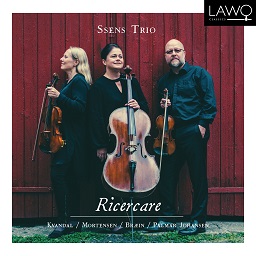Das Ssens Trio legt erneut, sowohl was Werkauswahl wie auch das Spiel anbelangt, eine spannende Einspielung vor. Dieses Mal wagt es sich an vier norwegische Kompositionen. Mit Ricercare ist nur eines der Werke, das von Johansen betitelt. Aber auch die anderen Stücke des Albums hätte man so benennen können. Die Bezeichnung ricercare kam im 16. Jahrhundert für Instrumentalfassungen von Motetten auf. Aufspüren oder erforschen steckt im Wortsinn.
Die Kompositionen der drei älteren Komponisten entstanden im selben Jahrzehnt unter dem Einfluss der Ideale des in Deutschland und Frankreich herrschenden Neoklassizismus.
Kvandal wollte frei und unabhängig sein, und das Trio für Streicher ist ein Schritt auf diesem Weg. Der erste Satz ist frei tonal und wie ein zuweilen streng geregelt Spiel, das zu anderen Zeiten mit spielerischen Ideen tanzt. Der zweite Satz hat eine eher nachdenkliche Qualität. Der dritte Satz kehrt zu der Verspieltheit und Freiheit zurück.
Mortensen hatte zwar Interesse an Paul Hindemith, konzentrierte sich aber auf die Zwölftonmusik. Das Trio hat im ersten Satz im Tempo wechselnde Abschnitte. Hier begeben sich die Instrumente dynamisch und metrisch auf unterschiedliche Linien. Der zweite Satz gliedert sich ebenfalls in Abschnitte. Der rhythmische Schwung des dritten Satzes führt mit phantasievollen Kontrast in helleren Registern in unerwartete Richtungen.
Bræin verdreht und wendet im Trio musikalische Motive und Themen zu überraschenden Variationen. Das Werk erklingt rhythmisch verspielt sowie mit metrischen Verschiebungen und Veränderungen im Klang, der auch eine ‘französische’ Polyphonie hören lässt.
Johansen, als Jüngster, hat sein Ricercare 1996 komponiert. Der erste Satz ist ähnlich wie ein altmodisches Ricercare mit wechselnder Textur zwischen freier und strenger Linearität aufgebaut. Der zweite Satz fügt das Augenmerk auf die Entwicklung des Klangs. Mit dem Hauptintervall Tritonus werden tonale Erwartungen enttäuscht. Der dritte Satz dehnt und lockert die Zeit.
Das Ssens Trio bietet erneut eine ebenso spannungsreich wie gekonnt dargebotene Stunde Musik an. Nach den vorherigen CDs mit großen Namen wie Beethoven und Mozart zeigen sie nun Musik aus ihrer Heimat. Und das gelingt ihnen mit dem gleichen Maß an Charme und Elan wie bei den beiden Aufnahmen zuvor. Mag auch die Musik dieser CD hier weniger bekannt sein und beim ersten Hören auch spröder klingen, so eröffnet sich doch gleich eine faszinierende Welt. Die Ähnlichkeiten werden ebenso angedeutet wie sie auch die persönlichen Lösungen der Komponisten deutlich darlegen. So nutzen die drei Musiker dieses Forschen zu bereichernden Entdeckungen. Dass ihr Spiel technisch mit anderen Streichtrios ebenbürtig ist und dass das gemeinsame Musizieren einen höchsten Grad an Abstimmung und Nähe zueinander gefunden hat, sind da nur die Voraussetzungen, die so ein Ergebnis ermöglichen. Ob man die Werke als Essenz norwegischer Kammermusik sehen will, ist das eine. Aber hier werden nicht nur die Grundzutaten geboten, sondern feinste Rezepte kredenzt.
Das informative Beiheft zu Komponisten und Werken rundet ebenso wie die gelungene aufnahmetechnische Realisierung diese Einspielung ab.
The Ssens Trio once again presents an exciting recording, both in terms of the choice of works and the ensemble’s playing. This time it ventures into four Norwegian compositions. Only one of the works, by Johansen is titled Ricercare. But also the other pieces of the album could have been named so. The term ricercare hardly appeared in the 16th century for instrumental versions of motets. To trace or explore is comprised in the literal sense.
The compositions of the three older composers were written in the same decade under the influence of the ideals of neoclassicism prevailing in France and Germany.
Kvandal wanted to be free and independent, and the Trio for Strings is a step along that path. The first movement is freely tonal and like a sometimes strictly regulated game that dances with playful ideas at other times. The second movement has a more reflective quality. The third movement returns to the playfulness and freedom.
Mortensen had an interest in Paul Hindemith, but focused on twelve-tone music. The trio has sections that change in tempo in the first movement. Here the instruments embark on different lines dynamically and metrically. The second movement is also divided into sections. The rhythmic sweep of the third movement leads in unexpected directions with imaginative contrast in lighter registers.
Bræin twists and turns musical motives and themes into surprising variations in the trio. The work sounds rhythmically playful as well as with metrical shifts and changes in sound that also allows one to hear a ‘French’ polyphony.
Johansen, as the youngest, composed his Ricercare in 1996. The first movement is structured much like an old-fashioned ricercare with alternating textures between free and strict linearity. The second movement adds attention to the development of the sound. With the main interval tritone tonality is not to be expected. The third movement stretches and loosens time.
The Ssens Trio once again offers an hour of music as exciting as it is skillfully presented. After the previous CDs with big names like Beethoven and Mozart, they now present music from their homeland. And they succeed in doing so with the same degree of charm and verve as in the two previous recordings. Even though the music on this CD may be less familiar here and sound more brittle at first hearing, a fascinating world opens up right away. The similarities are hinted at as well as the personal solutions of the composers are clearly presented. Thus the three musicians use this research to make enriching discoveries. The fact that their playing is technically on a par with other string trios and that the joint music-making has found a highest degree of attunement and closeness to each other are only the preconditions that make such a result possible. Whether one wants to see the works as the essence of Norwegian chamber music is one thing. But here not only the basic ingredients are offered, but the finest recipes are used.
The informative booklet on composers and works rounds off this recording, as does the successful technical realization.
https://www.pizzicato.lu/beethoven-mit-kommunikativer-spielfreude/




















